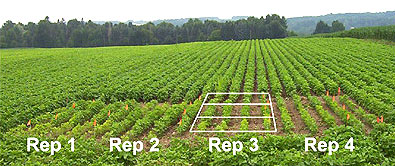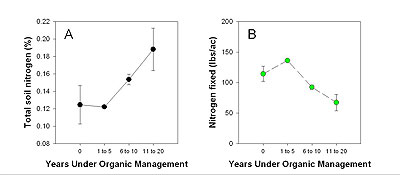Researching legume nitrogen fixation module
How does soil fertility affect legume N fixation?
As described in the legume N fixation learning module, high levels of available soil N can reduce N fixation. Past studies on the effects of soil N on legume N fixation have used conventional inorganic N fertilizers and very few studies have been conducted on working farms. Organic management practices can result in increased organic matter levels over time, which may result in reduced N fixation.
Research question: How does soil N fertility affect legume N fixation rates and total biomass production?
The experiment: Soybean N fixation was measured on 13 farm fields in the Finger Lakes region of New York. The fields ranged in management history from 0 to 20 years under organic management. How do we measure N fixation?

Figure 2. Soybean plots established within a kidney bean field. Each field contained 4 replicated plots of 3 soybean varieties. The varieties were Vinton 81 (a food-grade soybean), a forage soybean derived from the Chippewa line, and a non-nodulating mutant of the forage soybean.
Soils were sampled in each plot. What soil measurements do we use?
Nitrogen fixation results were then compared with the soil test results to see if any of the measures of soil N availability help explain the variability in soybean N fixation.
Preliminary results:
- The average percent of total soybean N that was fixed from the atmosphere was 58% for both soybean varieties tested, with the remaining N coming from the soil. The percent of N from fixation varied across the fields from 40 to 91 percent. That translates into a range of about 50 to 250 lbs of N/acre fixed from the atmosphere across the different fields.
- The average total N fixed was 115 lbs/acre. With an average of 103 lbs/acre of N harvested as seed, the net N contribution of the soybeans to the soil averaged about 12 lbs of N/acre.
- Organic matter levels and total soil N increased with time under organic management. The greatest amounts of N fixation occurred in transitional organic grain fields and rates of N fixation decreased with increasing soil organic matter levels (Figure 3). However, the effect of management history alone is unclear due to differences in soil texture across the fields. Some of the fields that had been in organic management the longest also have slightly higher clay levels than the other fields which may explain some of the increase in soil organic matter levels. Clay soils tend to have higher organic matter levels than sandier soils.

Larger image
Figure 3. A) Total soil nitrogen increased and, B) soybean nitrogen fixed decreased with time under organic management. Total soil N is highly correlated with total soil organic matter.
These results led to our next research questions:
- Are some legumes more responsive than others to differences in soil fertility?
- How much N do different legumes fix when grown intercropped with a grass?
See the preliminary results from our second field experiment:
How much N do different legumes fix when grown in pure stands and in mixtures with grasses?
© Copyright, Department of Horticulture, Cornell University.
Logo graphics by Rachel Kennedy.
Design by Craig Cramer.
Mention of trade names and commercial products is for educational purposes; no discrimination is intended and no endorsement by Cornell Cooperative Extension or Cornell University is implied. Pesticide recommendations are for informational purposes only and manufacturers' recommendations change. Read the manufacturers' instructions carefully before use. Cornell Cooperative Extension and Cornell University assumes no responsibility for the use of any pesticide or chemicals. Some of the links provided are not maintained by Cornell Cooperative Extension and Cornell University. Cornell Cooperative Extension and Cornell University are not responsible for information on these websites. They are included for information purposes only and no endorsement by Cornell Cooperative Extension or Cornell University is implied. Cornell Cooperative Extension provides equal program and employment opportunities.